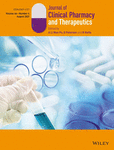Population pharmacokinetic analysis and dosing guidelines for tacrolimus co-administration with Wuzhi capsule in Chinese renal transplant recipients
Funding information
This work was supported by the National Natural Sciences Foundation Commission of China (No. 81860035), Wu Jieping Medical Foundation (No. 320.6750.19090-36) and Jiangxi Provincial Department of Science and Technology (No. 20201BBG71008).
Abstract
What is known and objectives
Tacrolimus (TAC) is a first-line immunosuppressant which is used to prevent transplant rejection after solid organ transplantation (SOT). However, it has a narrow therapeutic index and high individual variability in pharmacokinetics (PK) and pharmacogenomics (PG). It has been reported that the metabolism of TAC can be affected by genetic factors, leading to different rates of metabolism in different subjects. Wuzhi Capsule (WZC) is a commonly used TAC-sparing agent in Chinese SOT to reduce TAC dosing due to its inhibitory effect on TAC metabolism by enzymes of the CYP3A subfamily. The aims of this study were to assess the effect of TAC+WZC co-administration and genetic polymorphism on the pharmacokinetics of TAC, by using a population pharmacokinetic (PPK) model. A dosing guideline for individualized TAC dosing is proposed based on the PPK study.
Methods
The medical records of 165 adult patients with kidney transplant and their 824 TAC concentrations from two kidney transplantation centres were reviewed. The genotypes of four single-nucleotide polymorphisms (SNPs) in CYP3A5*3 and ABCB1 (rs1128503, rs2032582 and rs1045642) were tested by MASSARRAY. A PPK model was constructed by nonlinear mixed effect model (NONMEM®, Version 7.3). Finally, Monte Carlo simulations were employed to design initial dosing regimens based on the final model.
Results and discussion
The one-compartmental PPK model with first-order absorption and elimination of TAC was established in kidney transplant recipients (KTRs). CYP3A5*3 had significant impact on the PPK model. The haematocrit (HCT), postoperative time (POD) and CYP3A5*3 genotypes had a significant influence on TAC clearance when combined with WZC. The model was expressed as 23.4 × (HCT/0.3)−0.729 × 0.837 (combination with WZC) × e−0.0875(POD/12.6) ×1.18 (CYP3A5 expressors). For patients carrying the CYP3A5*3/*3 allele and with 30% HCT, the required TAC dose to achieve target trough concentrations of 10–15 ng/ml was 4 mg twice daily (q12h). For patients with the CYP3A5*3/*3 allele, the required dose was 3 mg TAC q12h when combined with WZC, and for patients with the CYP3A5*1/*1 or *1/*3 allele, the required dose was 4 mg of TAC q12h when co-administered with WZC.
What is new and conclusion
Wuzhi Capsule co-administration and CYP3A5 variants affect the PK of TAC Dosing guidelines are made based on the PPK model to allow individualized administration of TAC, especially when co-administered with WZC.
CONFLICT OF INTEREST
The authors declare no conflict of interest.




